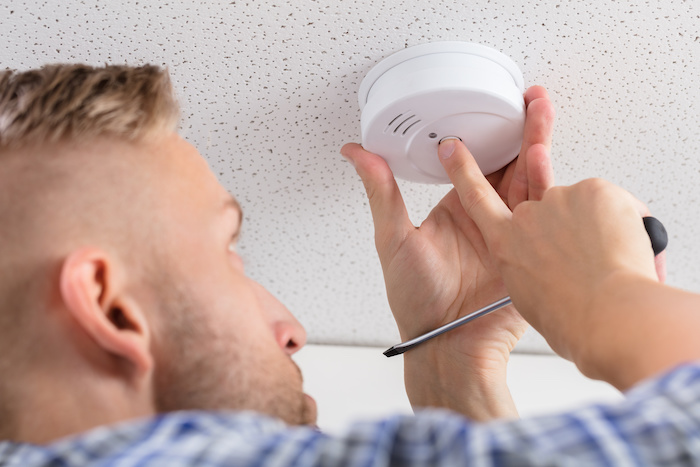
Carbon Monoxide poisoning is far more common than you might think. The colorless, odorless gas is a deadly and invisible menace. According to the CDC, every year, accidental Carbon Monoxide poisoning is responsible for at least 430 deaths in the United States, along with tens of thousands of emergency room visits. But you can protect yourself and your family. Take these simple, preventative measures to ensure your home is not at risk of prolonged Carbon Monoxide exposure.
Carbon Monoxide Poisoning: Causes, Symptoms, and Who’s at Risk
Carbon Monoxide is a byproduct produced when burning carbon based fuels like petrol, charcoal, coal and kerosene. Many commonplace household appliances utilize these fuels – think gas ovens, gas furnace systems, wood stoves and coal burners. While you shouldn’t be afraid to use modern gas appliances in your home, it’s important to be aware of how they function. Or in the case of Carbon Monoxide, being aware of the dangers of malfunctioning appliances, appliances that are old, faulty or not well maintained, or misusing any appliances in a dangerous way.
Symptoms of Carbon Monoxide Poisoning
A particularly frightening aspect to Carbon Monoxide poisoning is the fact that it can take an extended period of time before symptoms, and potential fatalities, to reveal themselves. What’s more, many of the symptoms that indicate Carbon Monoxide poisoning may be easily dismissed by pre existing conditions or the hustle and bustle of every day life. Symptoms like:
- Lethargy
- Headaches
- Nausea
- Confusion
- Dizziness
- Shortness of Breath
- Chest Pain
No one is immune to Carbon Monoxide poisoning. However, babies, elderly and those with compromised immune systems stemming from respiratory conditions, heart disease or anaemia are at a much greater risk. If you feel any combination of symptoms after spending an extended amount of time in your living space, and suspect Carbon Monoxide to be the culprit, get to fresh air as soon as possible and call 911 or a health professional right away.
Basic Carbon Monoxide Safety
Because of its elusiveness and difficulty to detect, Carbon Monoxide can be tricky to understand and prepare against. Which makes it very easy to overlook or not recognize in your home before it’s too late. But there are a few simple, important safety measures you can take in order to keep you and your family protected.
- Don’t warm up a vehicle or leave the engine running in your garage.
- Keep running generators in a well-ventilated area away from your home.
- Never use an oven or stovetop to heat your home.
- Keep fireplaces, furnaces, dryers, and stoves clear of debris before you use them.
Above all, make sure to have at least one CO alarm in your home. It will act just like a fire alarm, telling you when you are in danger. If it goes off, get outside to get fresh air immediately and call 911.
Utilize Monitored Smoke and CO Alarms For the Best Protection
By far the easiest and most important line of defense against CO poisoning is the use of a CO detector. But just like smoke alarms, CO alarms only go as far as letting you know that you’re in danger. It’s up to you to take those next steps to safety. But what if no one is home? What if it’s too late, and you or someone you love is already incapacitated due to Carbon Monoxide poisoning? In emergency moments where time is precious, a few minutes can be the difference between life and death.
While most homes and businesses utilize some form of battery-powered smoke alarms and CO detectors, monitored systems can add that extra layer of protection. Here’s how it works:
- My Alarm Center’s monitored CO and fire protection system detects smoke or carbon monoxide.
- Central Monitoring Station is alerted and calls the home to assess the situation, then the authorities if needed.
- First responders are dispatched, and arrive on scene in minutes rather than hours.
A monitored system not only detects the danger and attempts to contact you, but takes that next step to actually dispatch first responders. Those precious minutes could be the difference between life and death.
The Benefits of Monitored Smoke and Carbon Monoxide Detectors
At My Alarm Center, monitored CO and fire prevention systems are linked to our central monitoring. That means appropriate help can be summoned when an alarm goes off, whether you are home or not, even if the security alarm is not armed. Monitoring is especially important in cases where occupants are not capable of responding appropriately to a traditional alarm. Such as the elderly or disabled individuals, children, individuals already overcome by the effects of CO or smoke, and pets in an otherwise empty house. Firefighters recommend placing one monitored smoke/CO detector in every bedroom and living space.
And if you’re looking for more ways to keep yourself and your family safe, check out our home security and automation services at My Alarm Center. We offer a wide range of home security options to protect you and your family. If you’re ready to discuss our custom solutions, contact us today to learn more about our services and how we can help you prepare for what’s next.
